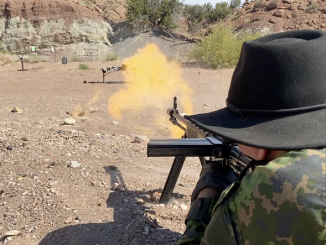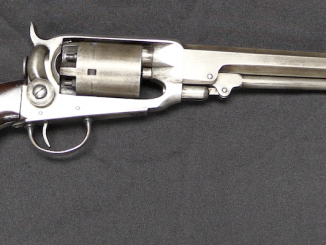Eugene Golubtsov – aka Lugerman – has been building beautiful .45 ACP Lugers base don the original DWM technical data package for the 1907 trial Luger for a little while now. We previously looked at one of his standard guns, and today I have a chance to do some shooting with the long-barrel target model. Of all the different varieties he makes (compact, classic, target, hunter, and carbine, in both .45 ACP and 10mm Auto) I think this is hands down the most awesome. And unlike the other .45 Lugers I have shot, these actually work!
And that’s exactly what a gun like this is for; to be awesome. Like a Rolex or a Ferrari, it is an extravagant example of what is possible beyond the limitations of practicality. For the people who can afford to indulge in this sort of thing, I think that it is a fantastic blend of historical inspiration, match accuracy, and solid reliable pistolsmithing. It sure does make that spinner look easy…




“You carried a huge and ludicrously expensive .45 pistol in your pants waistband to fend off a mugger? That’s total BS.” The police would confiscate the gun after such a “self-defense shooting” on the grounds that the user is TOTALLY NUTS, especially if he’s dumb enough to stick it in his pants!!
The king of range toys.
Want.
Spun the spinner in three rounds, nice. Could there be a 2GACM in this guns future?
I zoomed in on pics. Finish does not look very good to me Emblem on top looks “as cast”. Makes you wonder
Hi
I have a 45 caliber Luger and a 9mm Baby Luger. Both guns finish and function are amazing. Check out lugerman.com website. Eugene’s guns are amazing.
“(…)these actually work(…)”
Does this also apply to 10 mm version? If yes that means that Golubtsov mastered fine art of adjusting this design to particular cartridge. This also lead to question how would Herr Luger design cope with bigger “magnum” cartridge (if someone would wish to use such cartridges)?
It’s worth noting that contrary to commonly-held collector myth, the 9 x 19mm cartridge was not developed at the behest of the Reichswehr. it was actually the German police who asked for it, not for more “stopping power”, but to improve the feed reliability of the Parabellum, which tended to have feedway jams with the 7.65 x 21mm bottleneck round.
The 7.65mm Parabellum was developed in 1898, largely along the lines of the 7.63 x 25mm Mauser cartridge, just shorter to allow its accommodation in a grip-mounted magazine without making the pistol grip too deep front-to-back, which had been one of the problems with the earlier Borchardt pistol firing basically the same cartridge.
But what worked feed-wise in the Borchardt or C/96 with their vertical, Mauser rifle type magazines, did not work as well in the slanted magazine of the Parabellum. This was also borne out, oddly enough, by the Japanese Type Nambu and Type 14 pistols in 8 x 22mm; similar cartridge profile and magazine layout, similar feed problems.
It seems the Parabellum action works best with a cartridge with about a 3 to 1 length/beam ratio and a full-diameter bullet to help guide the round into the chamber.
Which means that the .45 ACP actually finishes up just a bit “short” in OAL, and the 10mm Auto would be slightly too “long”, to be optimal in terms of feed geometry.
This isn’t saying they can’t be made to work, just that it will never be easy to make them do so. And feed reliability will probably never be up to that of the 9 x 19mm version.
Which means they will always be better suited to the target range or the hunting field than the street or the battlefield.
cheers
eon
At least we’re not going to follow the usual myths about old guns. If only US Army Ordnance would give up on the “one-rifle-shot stop from 2 miles away” dream. I have yet to see the average grunt pull a one-rifle-shot kill on a person two miles downrange. Perhaps the intended victim was a plywood cutout. Oh, and speaking of service weapons programs, the most recent replacement for the Beretta M9, the SIG-Sauer M17, had been initially known to discharge upon the slide impacting hard ground if accidentally dropped back-end first. So much for the Army’s “thorough testing.”
In all of America’s wars, other than massed fire as seen in smoothbore musket and rifle-musket days, there are very few instances of rifle kills much beyond 100 yards other than specialized snipers.
(Note I did not say “specially-trained” snipers, because until the last thirty years, we’ve never done better at actually training snipers than anybody else has.)
As Jack Coggins once said, whether armed with an 1861 Springfield .58 rifle musket or a semiautomatic M1 Garand, the average citizen-soldier can barely hit a bull in the backside at 100 yards, let alone a man.
As such, it probably makes more sense to follow the policy the German Army adopted in two world wars. Namely, that the riflemen in the infantry squad are there mainly to hump ammunition for, and provide flank cover for, the squad machine gun, and then let the machine gun team get on with the business of killing the enemy out to 1000 meters or so.
Seen in this light, the adoption of 5.56 x 45mm SAWs can only be seen as the result of a fundamental misunderstanding of the squad machine gun’s actual job.
cheers
eon
Back to 1899-
https://en.wikipedia.org/wiki/The_Theory_of_the_Leisure_Class
Back to 2019, and forward to 2119… In unlikely event we arrive there, mind you they said that in 999; but via a big annoyed God.
Which, unlike them; we probably, won’t.
https://youtu.be/HRkXbTTYfSU
“Back to 2019, and forward to 2119… In unlikely event we arrive there, mind you they said that in 999;(…)”
Ehh.. end of world? Again? How many times that was announced?
?? I just meant that Ian seemed to be hunting around for Veblen’s term, “conspicuous consumption”. This lethal toy is certainly a great example thereof.
It is, your right.
“Where do they get all these wonderful toys!?”
Looks like you can get these with contoured grips that might feel better: https://lugerman.com/product/luger-45-1907-target/